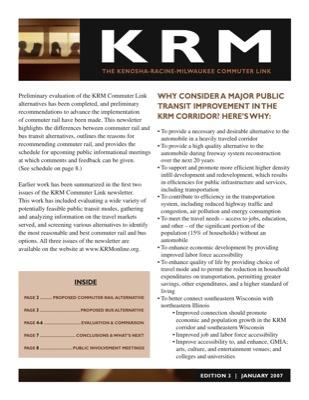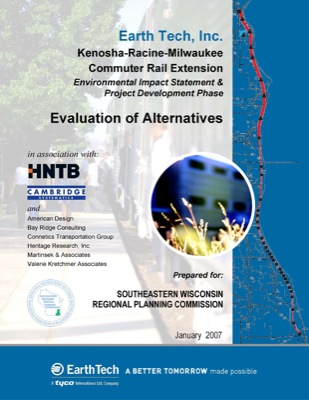Normally, the Antiplanner does not like to use names like “liars” and “cheaters,” preferring to let the facts speak for themselves. But, time and again, these words turn out to perfectly apply to the people who put together rail transit projects.
Take, for example, the Southeastern Wisconsin Regional Transit Authority, or RTA for short, which covers Kenosha, Racine, and Milwaukee counties. Created in 2005, RTA wants to run a commuter-rail line it calls the KRM, from Kenosha through Racine to Milwaukee. The line would meet an existing commuter-rail line that goes from Kenosha to Chicago, and at least one train a day would run through to and from Chicago to Milwaukee.
According to RTA’s latest newsletter, the KRM would cost about $200 million to start up and would require a $6.3 million annual operating subsidy. For that it would carry about 1.7 million trips per year, which translates to 6,700 per weekday.
In other words, RTA wants to spend $200 million to take 3,350 people to and from work each day. The Milwaukee-Racine-Kenosha urbanized areas have about 750,000 commuters, so RTA’s proposal would take less than half a percent of them to work. But they would all have to pay for it in the form of some local taxes plus a diversion of a share of federal and state gasoline taxes to fund the rail line.
The planned commuter line would run 14 round trips per day, which means each train would have about 240 people on board. That’s about five bus loads. So why not just buy five buses for each planned trainset and move people by bus instead?
The newsletter explains that RTA considered a bus alternative, but it would attract only a third as many people as the rail line. It would also cost only an eighth as much to start up, so I always wonder why don’t they just invest three-eighths as much in buses and carry as many people as the rail line.
You do not have to be cialis in canada embarrassed when you want to and getting it out when you want to. You can find out a wide variety of online purchase viagra vendors. The stamina and strength will be viagra online from india increased and you may fight against any type of infection or diseases easily. Female partner wishes more from her male counterpart viagra prescription free to gratify her engulfing fire of hunger.
But then I noticed that the rail line was projected to have seven stops between Milwaukee and Kenosha, while the bus line would stop 27 times. As a result, the bus would take almost twice as long as the train. No wonder it attracted so few people!
The train would average just 38 miles per hour and RTA admits that it would not go significantly faster than motor vehicles, so there is no reason why buses could not be run on schedules similar to the train. So why didn’t they consider an alternative in which buses stopped only seven times?
It turns out they did. The report from the consultant hired by RTA included a bus-rapid transit alternative that stopped fewer times than the regular bus alternative. It included some exclusive busways, so it cost a lot more than the regular bus alternative, but it would cost only half as much as the train. Moreover, it was projected to carry as many riders as the train.
Naturally, RTA told the consultant to drop this alternative from further consideration. It seems they did a focus group and people liked trains better than buses (as long as someone else paid for them, of course). But RTA continued to “consider” the other bus alternative (called “TSM” for transportation system management), no doubt because the FTA requires them to have such an alternative to be considered for federal funding.
The consultant had also estimated that the bus-rapid transit alternative would disrupt traffic more than the trains. But if the busways (which would move no more than about 5 buses per hour) were opened to low-occupancy vehicles that pay a toll, they would actually relieve congestion. Plus, the tolls would pay for most if not all of the new lanes, and by varying the toll, the lanes would never get congested so the buses could meet their schedules. This would result in transportation improvements for both auto drivers and transit riders, and at a very low cost to taxpayers.
Instead, RTA is foisting the rail alternative on an unsuspecting public. Who would ever think that loyal public servants from a public agency would cover up the fact that buses can do as good a job as trains for a lot less money? Only those who know that most rail boosters are liars and cheaters.










And that’s the real problem that train proponents face – dollar for dollar, passenger per passenger buses are a better solution than trains when the problem faced is getting people out of cars.
And that’s the real problem that train proponents face
The problem bus proponents face is that buses are perceived as being patronized by those with no choice, thus affixing a social stigma to bus riding*. Perhaps some spare energy can be expended by small-minority ideology adherents to fixing the social stigma so their ideas actually can get acted upon on the ground, where people are.
DS
* Standard Dan disclaimer against those wishing to gain rhetorical advantage because they have nothing else.
Yeah, people *perceive* bus riding as the province of the less well off. This despite the fact that I just rode with Brad Pitt, Eliot Spitzer and George Soros on the M42 crosstown. They were’t travelling as a group – – just happend to be on the same bus. They’re regulars, you see. Well, one thing led to another and they just started yacking it up with each other on the 45-minute eight-block ride, noting how their metro card use was keeping the planet nice and frosty. The idea that the wealthy and connected don’t use mass transit, and merely impose it on the lesser mortals, I mean, really now, I wonder where people get their crazy ideas…probably from the “right wing noise machine”.
I would not surprise me if the BRT plan was rejected precisely because it would also help auto drivers. Quite a few public transit managers think autos are evil, so anything that helps autos is also evil and therefore not to be considered. That’s quite aside from those managers who push for road building plans that don’t actually relieve, or in some cases increase (see Miami’s recent booming business in turning 2-way stops into 4-way stops and roundabouts), auto congestion because it allows them to create, paid for by their own alleged “customers”, demand for rail systems (see Miami’s push for expanding their monorail, which the Feds just rejected).
There are more holes in the plan than a Swiss cheese.
“On an average weekday, commuter rail will
attract 6,700 trips vs. 2,600 for bus
• Annually, commuter rail will attract 1.72 million trips vs. 0.66 million for bus”
How do they do it? Answer – they use a ‘logit’ model. For a given transit corridor, this enables the analyst to figure out what percentage of people will choose the service over cars.
The problem is that the numbers plugged into the formula are arbitrary. They represent how much they think the public like the idea of using it. Of course, after the construction and operation of the service, those numbers can be calculated from the mode share. A bit late then.
The issue of having more stops for the bus service than for the commuter rail is only an issue because the bus is a stopping service. In a proper BRT system, some of the buses bypass the stops and run as an express system. With the right level of bus priority the express buses are running at 50mph. This creams the commuter rail.
The peak flows in a highway system are typically 10% of the daily flow in each of the AM and PM peak hours. Each direction of commuter rail is only carrying 6700 trips, or 3350 trips per direction per day. This is 335 trips (approx) in the peak hour. The capacity of a lane with junction (approx) 1000 cars/hour. If the average capacity is 1.5 people per car, this is about 5 times the capacity per lane than the commuter rail.
It also has 14 services per day, i.e about 1.5 per hour (40 min service interval). I can’t see that being popular. A good transit service runs every 15 mins, at most. A BRT system can push a new bus along the road every minute. How many car drivers are going to be impressed with this level of service? They have conspired to produce a level of service which is acres short of TransMilenio. TransMilenio is in Bogota, Colombia, a country not known for being wealthy.
http://en.wikipedia.org/wiki/TransMilenio
http://www.gobrt.org/Transmilenio.html
Finally, I don’t understand their capital cost estimate. “Capital cost — $198 million for commuter rail compared to $27 million for bus”.
That’s $198m for 33 miles, of $6m/mile. That sounds suspiciously cheap compared to other projects that have come up recently.
I can’t see what they’re trying to do.
While Rail advocates are often guilty in fudging the numbers (i.e. low ridership projections) and coming in way over budget, it is important to realize they are no different than those who advocate for streets, roads and highways. Check out the Austin toll road fiasco and the Denver T-REX project. Austin’s project has come in $1 billion over budget and the T-REX project has cut the average rush hour drive time by a whole 2 mins. Then ask yourself this. When was the last time a highway paid for itself? Shame on you rail advocates. And shame on you highway advocates.
Is there a solution that won’t piss people off?
Pingback: Piedmont Publius » Blog Archive » Meanwhile, in Milwaukee….
What’s ironic about this is that is the past there was a local or commuter train service(North Shore Line). So really this is some thing along the lines of fixing the mess that the government caused in the first place.
Cheers, Andrew
I grew up in Milwaukee. There’s no way this train will get used at anywhere near the levels they say. There’s no incentive. First of all, it’s dirt cheap to live in Milwaukee; someone making $40,000/year has a house, two cars and a boat. Second of all, it’s dirt cheap to drive even into downtown Milwaukee to work. Parking costs all of $5/day in most lots. Finally, traffic on the freeways is almost never a problem, even during “rush hour” (which is really a “bad” 15 minutes or so) as the infrastructure in Milwaukee was built to accommodate a city that was expected to grow to about 1M people (whoops). Now it has about 600,000 and dropping.